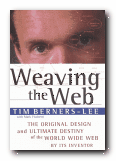the history of the Web – by the man who invented it
Everybody knows that Tim Berners-Lee is the man who invented the World Wide Web – and that he hasn’t become a millionaire. Weaving the Web explains the reasons why. It’s his own account of one of the most profound developments in twentieth century technology – almost as important as the invention of the Net itself. His story begins in one of the spiritual homes of computing – Manchester UK – where his both his parents worked on the first commercial mainframes made by Ferranti in the 1950s.
 He wrote his first program to link information in 1980 with “no loftier reason than to help me remember the connections amongst the various people, computers and projects at the [CERN] lab”. He was concerned to share information amongst a community of scientists who were equipped with different languages, different computers, and different operating systems – and it’s interesting to note the persistence of this altruism as the development unfolds.
He wrote his first program to link information in 1980 with “no loftier reason than to help me remember the connections amongst the various people, computers and projects at the [CERN] lab”. He was concerned to share information amongst a community of scientists who were equipped with different languages, different computers, and different operating systems – and it’s interesting to note the persistence of this altruism as the development unfolds.
His narrative is the now-familiar one of noble intentions battling against indifference, resistance, and outright opposition. There is a wonderful sense of intellectual excitement in following the step-by-step struggle to convince people that information could be linked and shared. And all this is as recent as 1990.
There were also conceptual difficulties. Ten years ago, people on the Net were regularly ‘lost in Cyberspace’ – an expression you don’t see used much any more. How difficult it was for most of us to conceptualize all this back in the early 1990s. It was not an easily intuitive thing to take in that when you clicked on a link you were ‘going’ to a computer at the other side of the world. Worse still – when the connection dropped, you felt as though you had fallen out of an aeroplane in mid-Atlantic. We’ve learned since not to worry when something disappears off the screen.
He discusses the competing systems such as Gopher and WAIS [remember those] and the strategic advantage of making SGML the base for hypertext markup language [HTML], the lingua franca of the Web. He is also forthright enough to admit his own failings, and even describes a conference paper which was rejected, as well as a rather sadly uneventful meeting with Ted Nelson in 1992. There’s also an explanation of how the rather clumsy term URL came about, though he continues to use URI [Indicator] throughout the book.
Once the Web takes off in the early 1990s, people such as Jim Clark and Marc Andreesson start to come into the picture. But whilst they make their fortunes turning Mosaic into Netscape, Berners-Lee selflessly devotes his energies to keeping the Web universal, out of the control of individual interests.
It has to be said that the story begins to dip a little at this point, with important but less dramatic decisions to be taken about protocols and standards.
 By 1996 we’re deep into the details of the Web Consortium [WC3] and its workings. The story picks up again as he covers the Netscape-Microsoft squabble and the move towards extensible markup language [XML]. He goes on to discuss the problems of encryption, privacy, censorship, domain name registration, and policies which should be in place to protect the individual. He also indulges in a little futurism, speculating about the consequences of permanent online connections [Yes please!] and the benefits of XML, which he strongly endorses. His account culminates with a prediction that the Web will evolve into what he calls the ‘Semantic Web’ – a system whereby information will be more intelligently and qualitatively structured.
By 1996 we’re deep into the details of the Web Consortium [WC3] and its workings. The story picks up again as he covers the Netscape-Microsoft squabble and the move towards extensible markup language [XML]. He goes on to discuss the problems of encryption, privacy, censorship, domain name registration, and policies which should be in place to protect the individual. He also indulges in a little futurism, speculating about the consequences of permanent online connections [Yes please!] and the benefits of XML, which he strongly endorses. His account culminates with a prediction that the Web will evolve into what he calls the ‘Semantic Web’ – a system whereby information will be more intelligently and qualitatively structured.
It’s a relatively easy book to read. I had the impression that it’s a transcript of interviews. And he ends, rather surprisingly, by revealing his belief in parallels between the Web and a ‘non-religious’ faith he has taken up in the US. But one thing remains constant throughout – his passionate desire to keep the Web an open, international standard – and for that we can all be grateful.
© Roy Johnson 2000
Tim Berners-Lee, Weaving the Web, London: Orion Books, 1999, pp.244, ISBN 0752820907
More on computers
More on technology
More on digital media